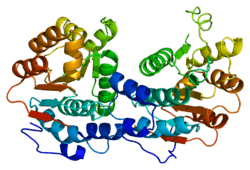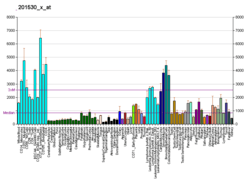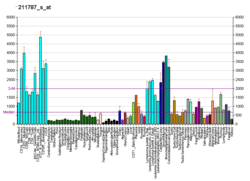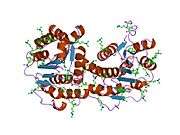EIF4A1
Eukaryotic initiation factor 4A-I is a protein that in humans is encoded by the EIF4A1 gene.[5][6][7]
Interactions
EIF4A1 has been shown to interact with EIF4E[8][9] and eukaryotic translation initiation factor 4 gamma.[8][9][10]
References
- 1 2 3 GRCh38: Ensembl release 89: ENSG00000161960 - Ensembl, May 2017
- 1 2 3 GRCm38: Ensembl release 89: ENSMUSG00000059796 - Ensembl, May 2017
- ↑ "Human PubMed Reference:".
- ↑ "Mouse PubMed Reference:".
- ↑ Kim NS, Kato T, Abe N, Kato S (Jun 1993). "Nucleotide sequence of human cDNA encoding eukaryotic initiation factor 4AI". Nucleic Acids Res. 21 (8): 2012. doi:10.1093/nar/21.8.2012. PMC 309447. PMID 8493113.
- ↑ Jones E, Quinn CM, See CG, Montgomery DS, Ford MJ, Kölble K, Gordon S, Greaves DR (Dec 1998). "The linked human elongation initiation factor 4A1 (EIF4A1) and CD68 genes map to chromosome 17p13". Genomics. 53 (2): 248–50. doi:10.1006/geno.1998.5515. PMID 9790779.
- ↑ "Entrez Gene: EIF4A1 eukaryotic translation initiation factor 4A, isoform 1".
- 1 2 Ewing RM, Chu P, Elisma F, Li H, Taylor P, Climie S, McBroom-Cerajewski L, Robinson MD, O'Connor L, Li M, Taylor R, Dharsee M, Ho Y, Heilbut A, Moore L, Zhang S, Ornatsky O, Bukhman YV, Ethier M, Sheng Y, Vasilescu J, Abu-Farha M, Lambert JP, Duewel HS, Stewart II, Kuehl B, Hogue K, Colwill K, Gladwish K, Muskat B, Kinach R, Adams SL, Moran MF, Morin GB, Topaloglou T, Figeys D (2007). "Large-scale mapping of human protein-protein interactions by mass spectrometry". Mol. Syst. Biol. 3 (1): 89. doi:10.1038/msb4100134. PMC 1847948. PMID 17353931.
- 1 2 Connolly E, Braunstein S, Formenti S, Schneider RJ (May 2006). "Hypoxia inhibits protein synthesis through a 4E-BP1 and elongation factor 2 kinase pathway controlled by mTOR and uncoupled in breast cancer cells". Mol. Cell. Biol. 26 (10): 3955–65. doi:10.1128/MCB.26.10.3955-3965.2006. PMC 1489005. PMID 16648488.
- ↑ Harris TE, Chi A, Shabanowitz J, Hunt DF, Rhoads RE, Lawrence JC (Apr 2006). "mTOR-dependent stimulation of the association of eIF4G and eIF3 by insulin". EMBO J. 25 (8): 1659–68. doi:10.1038/sj.emboj.7601047. PMC 1440840. PMID 16541103.
Further reading
- Reddy NS, Roth WW, Bragg PW, Wahba AJ (1988). "Isolation and mapping of a gene for protein synthesis initiation factor 4A and its expression during differentiation of murine erythroleukemia cells". Gene. 70 (2): 231–43. doi:10.1016/0378-1119(88)90195-3. PMID 3215517.
- Kukimoto I, Watanabe S, Taniguchi K, Ogata T, Yoshiike K, Kanda T (1997). "Characterization of the cloned promoter of the human initiation factor 4AI gene". Biochem. Biophys. Res. Commun. 233 (3): 844–7. doi:10.1006/bbrc.1997.6555. PMID 9168945.
- Imataka H, Sonenberg N (1997). "Human eukaryotic translation initiation factor 4G (eIF4G) possesses two separate and independent binding sites for eIF4A". Mol. Cell. Biol. 17 (12): 6940–7. doi:10.1128/mcb.17.12.6940. PMC 232551. PMID 9372926.
- Gradi A, Imataka H, Svitkin YV, Rom E, Raught B, Morino S, Sonenberg N (1998). "A novel functional human eukaryotic translation initiation factor 4G". Mol. Cell. Biol. 18 (1): 334–42. doi:10.1128/mcb.18.1.334. PMC 121501. PMID 9418880.
- Craig AW, Haghighat A, Yu AT, Sonenberg N (1998). "Interaction of polyadenylate-binding protein with the eIF4G homologue PAIP enhances translation". Nature. 392 (6675): 520–3. doi:10.1038/33198. PMID 9548260.
- Henis-Korenblit S, Strumpf NL, Goldstaub D, Kimchi A (2000). "A novel form of DAP5 protein accumulates in apoptotic cells as a result of caspase cleavage and internal ribosome entry site-mediated translation". Mol. Cell. Biol. 20 (2): 496–506. doi:10.1128/MCB.20.2.496-506.2000. PMC 85113. PMID 10611228.
- Quinn CM, Wiles AP, El-Shanawany T, Catchpole I, Alnadaf T, Ford MJ, Gordon S, Greaves DR (1999). "The human eukaryotic initiation factor 4AI gene (EIF4A1) contains multiple regulatory elements that direct high-level reporter gene expression in mammalian cell lines". Genomics. 62 (3): 468–76. doi:10.1006/geno.1999.6031. PMID 10644445.
- Cuesta R, Xi Q, Schneider RJ (2000). "Adenovirus-specific translation by displacement of kinase Mnk1 from cap-initiation complex eIF4F". EMBO J. 19 (13): 3465–74. doi:10.1093/emboj/19.13.3465. PMC 313943. PMID 10880459.
- Mendell JT, Medghalchi SM, Lake RG, Noensie EN, Dietz HC (2000). "Novel Upf2p orthologues suggest a functional link between translation initiation and nonsense surveillance complexes". Mol. Cell. Biol. 20 (23): 8944–57. doi:10.1128/MCB.20.23.8944-8957.2000. PMC 86549. PMID 11073994.
- Li W, Belsham GJ, Proud CG (2001). "Eukaryotic initiation factors 4A (eIF4A) and 4G (eIF4G) mutually interact in a 1:1 ratio in vivo". J. Biol. Chem. 276 (31): 29111–5. doi:10.1074/jbc.C100284200. PMID 11408474.
- Du MX, Johnson RB, Sun XL, Staschke KA, Colacino J, Wang QM (2002). "Comparative characterization of two DEAD-box RNA helicases in superfamily II: human translation-initiation factor 4A and hepatitis C virus non-structural protein 3 (NS3) helicase". Biochem. J. 363 (Pt 1): 147–55. doi:10.1042/0264-6021:3630147. PMC 1222461. PMID 11903057.
- Bohnsack MT, Regener K, Schwappach B, Saffrich R, Paraskeva E, Hartmann E, Görlich D (2002). "Exp5 exports eEF1A via tRNA from nuclei and synergizes with other transport pathways to confine translation to the cytoplasm". EMBO J. 21 (22): 6205–15. doi:10.1093/emboj/cdf613. PMC 137205. PMID 12426392.
- Yang HS, Cho MH, Zakowicz H, Hegamyer G, Sonenberg N, Colburn NH (2004). "A novel function of the MA-3 domains in transformation and translation suppressor Pdcd4 is essential for its binding to eukaryotic translation initiation factor 4A". Mol. Cell. Biol. 24 (9): 3894–906. doi:10.1128/MCB.24.9.3894-3906.2004. PMC 387765. PMID 15082783.
- Mingot JM, Bohnsack MT, Jäkle U, Görlich D (2004). "Exportin 7 defines a novel general nuclear export pathway". EMBO J. 23 (16): 3227–36. doi:10.1038/sj.emboj.7600338. PMC 514512. PMID 15282546.
- Hinton TM, Coldwell MJ, Carpenter GA, Morley SJ, Pain VM (2007). "Functional analysis of individual binding activities of the scaffold protein eIF4G". J. Biol. Chem. 282 (3): 1695–708. doi:10.1074/jbc.M602780200. PMID 17130132.
- Ewing RM, Chu P, Elisma F, Li H, Taylor P, Climie S, McBroom-Cerajewski L, Robinson MD, O'Connor L, Li M, Taylor R, Dharsee M, Ho Y, Heilbut A, Moore L, Zhang S, Ornatsky O, Bukhman YV, Ethier M, Sheng Y, Vasilescu J, Abu-Farha M, Lambert JP, Duewel HS, Stewart II, Kuehl B, Hogue K, Colwill K, Gladwish K, Muskat B, Kinach R, Adams SL, Moran MF, Morin GB, Topaloglou T, Figeys D (2007). "Large-scale mapping of human protein-protein interactions by mass spectrometry". Mol. Syst. Biol. 3 (1): 89. doi:10.1038/msb4100134. PMC 1847948. PMID 17353931.
This article is issued from
Wikipedia.
The text is licensed under Creative Commons - Attribution - Sharealike.
Additional terms may apply for the media files.







